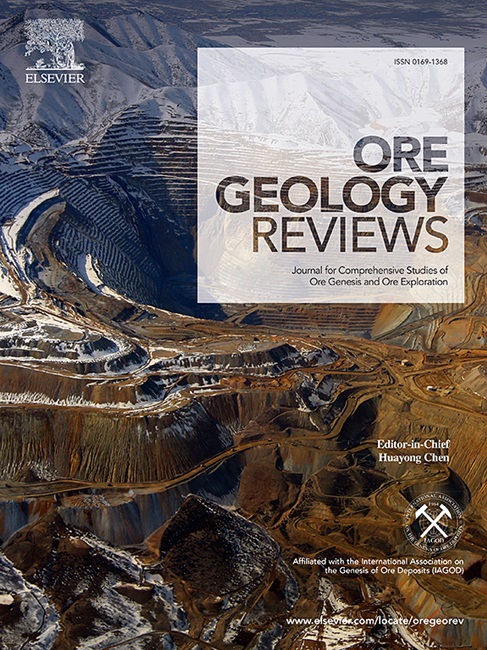摩洛哥Anti-Atlas中部Jbel N 'Zourk铜矿的地质背景、矿物学和同位素特征
IF 3.6
2区 地球科学
Q1 GEOLOGY
引用次数: 0
摘要
位于Anti-Atlas中部的Jbel N 'Zourk铜矿保留了反映复杂地层历史的结构和矿物学特征。高品位铜矿化主要局限于早寒武统阿斗斗组下段碳酸盐岩、粉砂岩和蒸发岩层。成矿作用在空间上与一条突出的nnw - se向断裂有关,该断裂可能对整个地区铜成矿的定位和富集起了至关重要的作用。矿化表现为块状、浸染状和网状的铜硫化物,如斑铜矿、黄铜矿和辉钼矿。矿伴生方解石δ13C值为−9 ~ + 2.9‰,δ18O值为+ 19.5 ~ + 22‰。这些同位素特征表明碳的混合来源,可能包括有机物脱羟基作用和海相碳酸盐溶解。氧同位素特征表明成矿作用受成岩作用的影响,而斑岩硫同位素数据(δ34S: 13.3 ~ 21.6‰)表明海相硫酸盐是主要硫源。δ34S数据与海相阿杜乌尼组的蒸发层序和碳酸盐层序表明,热化学硫酸盐还原作用(TSR)是主要作用,将硫酸盐转化为硫化物,有利于Cu的沉积。成矿流体的演化经历了深部热液运移、硫酸盐相互作用驱动tsr驱动硫化物沉淀、流体再活化等过程。这种动力系统受偶发性流体脉冲的影响,在地壳浅层岩溶洞内形成了网状结构和开放空间充填结构。这些特征支持了富铜热液成矿模型,其中断层和褶皱构造在Variscan构造事件期间形成或重新激活,是Jbel N 'Zourk矿床沉积的主要控制因素。本文章由计算机程序翻译,如有差异,请以英文原文为准。

Geological setting, mineralogy, and isotopic characterization of the Jbel N’Zourk copper deposit, central Anti-Atlas, Morocco
The Jbel N’Zourk copper deposit in the central Anti-Atlas preserves textural and mineralogical features reflecting a complex formation history. High-grade copper mineralization is predominantly confined to the carbonate, siltstone, and evaporite layers within the lower members of the Early Cambrian Adoudou Formation. The mineralization is spatially associated with a prominent NNW-SSE-trending fault, which likely played a crucial role in the localization and concentration of copper mineralization across the region.
The mineralization is manifested by massive, disseminated, and stockwork occurrences of Cu-sulfides such as bornite, chalcopyrite, and digenite. Stable isotope analyses of the ore-associated calcite yield δ13C values ranging from −9 to + 2.9 ‰ and δ18O values from + 19.5 to + 22 ‰. These isotopic signatures suggest a mixed origin of carbon, likely encompasing organic matter dehydroxylation and marine carbonate dissolution. Oxygen isotope signatures indicate significant diagenetic processes affected mineralization, while sulfur isotope data of bornite (δ34S: 13.3–21.6 ‰) suggest marine sulfate as the primary sulfur source. The δ34S data, along with the evaporitic and carbonate sequences in the marine Adoudounian Formation, demonstrate that thermochemical sulfate reduction (TSR) was the dominant process, converting sulfate into sulfide and facilitating Cu deposition.
The evolution of ore fluids progressed through deep-seated hydrothermal fluid migration, sulfate interaction driving TSR-driven sulfide precipitation, and subsequent fluid remobilization. This dynamic system, influenced by episodic fluid pulses, resulted in stockwork and open-space filling textures within karstic cavities at shallow crustal levels. These features support a model of Cu-rich hydrothermal mineralization, where faults and folded structures, formed or reactivated during the Variscan tectonic events, were the main controls on ore deposition at Jbel N’Zourk.
求助全文
通过发布文献求助,成功后即可免费获取论文全文。
去求助
来源期刊

Ore Geology Reviews
地学-地质学
CiteScore
6.50
自引率
27.30%
发文量
546
审稿时长
22.9 weeks
期刊介绍:
Ore Geology Reviews aims to familiarize all earth scientists with recent advances in a number of interconnected disciplines related to the study of, and search for, ore deposits. The reviews range from brief to longer contributions, but the journal preferentially publishes manuscripts that fill the niche between the commonly shorter journal articles and the comprehensive book coverages, and thus has a special appeal to many authors and readers.
 求助内容:
求助内容: 应助结果提醒方式:
应助结果提醒方式:


